

- The Space Race to the Moon was always expected to be just the beginning of eventual exploration and settlement farther beyond to Mars, the Asteroids and eventually the stars. All this by the end of the century. But without the rivalry with the Russians, space followup projects were abandoned and the Apollo program cancelled. But what if the Soviets had managed to remain somewhat competitive and the drive to continue the race still existed into the 70s and beyond? How would the world look today?
Timeline[]
1967 January 27th The crew of Apollo 1 died tragically in a fire that kills both the crew members and NASA's chance for an early manned Apollo flight.
POD
March 10th-17th Despite enormous risk to the crew, the first Soviet Zond spacecraft on a UR-500 Proton rocket, successfully carried Cosmonauts Alexi Leonov and Mackarov Grigoriyevich on the first manned circumlunar flight. The mission was a near disaster however with the parachute almost getting tangled on re-entry. The planned Soyuz 1 and 2 docking mission is delayed until the problem can be resolved.Space suits were also added to all further flights to prevent another near-depressurization in space. The Zond 1 mission also marks and important ideological victory of the American's after their embarrassing Apollo 1 incident, it also be the 60th anniversary of the October Revolution and the only spaceflight of the year.
1968
October 11th: Faced with the prospect of a new Soviet lead in the Moon race the Americans launch Apollo 7 on an Earth Orbit test mission. The crew spent 11 days in testing out the systems for Rendezvous and Docking the Apollo. This important success would soon be overshadowed by the Soviets, however.
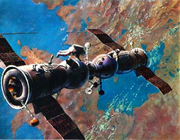
October 25th: The long delayed and redesigned Soyuz finally flew for the first time. Soyuz 1 piloted by Vladimir Komarov and Soyuz 2 piloted by Cosmonauts Bkovfsky, Khrunov and Yeliseyev. The crews performed the first ever in space docking by two manned spacecraft. The crews also successfully performed the first ever exchange of crews in orbit (an important milestone for the planned Soviet Lunar Landing). The crew also set a new duration record blowing Gemini's 14 days out of the water, total of 22 days in Space.
In the wake of mounting Soviet successes in Space, President Lyndon B Johnson in a Kennedy like speech committed the United States to going "Faster, Farther and longer" than the Soviets ever could by committing the nation to "Piloted flights around the planets Mars and Venus by the mid 1970s"
September and October: Taking advantage of the speech the Soviets "showed us up" by launch two more successful circumlunar Zond (Zond 2 & 3) flights dropping American prestige by another two points. Many claim a Soviet lunar landing is imminent.
December 21st-27th: The Apollo 8 becomes the first manned spacecraft to enter orbit around the Moon. While the mission was a huge victory for the Americans the previous soviet victories reminded them the Space Race was far from over.
1969
January 16th-17th The upcoming Apollo 9 flight was once again upstaged by a similar Soviet mission. As the Soyuz 5 and 4 crews performed yet another successful docking and crew exchange in Earth Orbit. This time the spacewalk from one spacecraft to the other was televised live to the people of the US and USSR. While the Soviets where performing impressive space feats many recognised they had not yet demonstrated heavy lift launch capacity. Las Vegas Casinos began betting on who would make it to the moon first.
March 3rd-13th Apollo 9 performs a Earth Orbit, Lunar Module test flight.
May 18th-26th Apollo 10
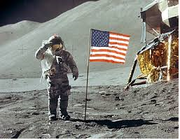
July 16th-24th: Apollo 11 Astronauts Neil Armstrong and Buzz Aldrin land on the sea of Tranquility while Michael Collins waits patiently in Lunar Orbit. The Moon is also met by the unmanned Luna 15 lander that successfully beat the Americans to bringing back the first sample of the Moon and launching the first sample from the moon beating Apollo 11 by just hours.
October 11th to 16th: The Soyuz 6, 7 and 8 spacecraft successfully perform the first triple rendezvous of three manned spacecraft in Orbit. This fuels speculation the Soviets may be attempting on orbit assembly of a large space station. Despite this NASA funding is cut in the wake of a victory and 'end of the moon race'
November 14th-24th: The Americans finish the year with the successful launch of Apollo 12.
1971
April 19th: The Soviet Union after a year of relative silence (during which many claimed the space race had ended) returned with the successful launch of Salyut 1, the world's first Space Station.
April 22nd-May 15th: The USSR quickly launched their Soyuz 10 spacecraft to begin occupying the station. The crew successfully entered the station and crewed it for a total of 23 days.
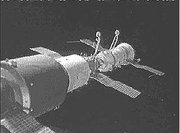
June 5th-July 5th: The Soyuz 11 spacecraft performs the second Docking to Salyut 1 setting another record duration achievement of one month in space. There was a slight mishap on re-entry when the capsule depressurized, but the crew was unharmed thanks to their pressure suits added on all flights since Zond 1.

July 15th-August 29th: In the wake of Soyuz 11's success, Soyuz 12 was dispatched to occupy the station again after just ten days of inoccupation. The crew commanded by Voskhod 2 and Zond 1 veteran Alexi Leonov once again set another duration record now standing at 45 days.
All this was done while the Apollo 13 mission had suffered a near-fatal accident on route to the moon. This surge in duration flights lead to speculation of possible preparation of interplanetary and that the real goal was not the Moon at-all. In 1971 President Nixon announced plans for a round two, to the Space Race, mainly the construction of large permanent bases in Earth Orbit, the Moon and Mars all within a decade, The space race was far from over.
1972
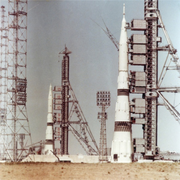
Apollo 16 and 17 kick off the beginning of the Spaceflight year with more Extended LM-Rover landings on the Moon. Other than that it was a pretty uneventful year ... until November 23rd-December 1st: The Soviets performed their first successful N1-L3 mission. While the N-1 rocket came close to failing yet again the vehicle managed to hold together this time and the second stage fired. The unpiloted LOK-LK complex safely entered orbit, landed on the Moon and returned. This fully unmanned dress rehearsal paved the way for the first Soviet's first piloted Lunar Landing, L1-1 in December of 1972.
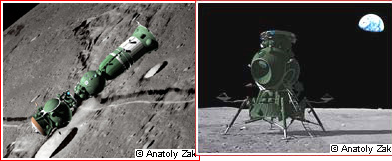
L1-1 was piloted by veteran cosmonauts Alexi Leonov, Mackorev Grigoriyevich, both of whom had previously flown to the Moon together on Zond 1. While Mackorev remained in Lunar Orbit in the LOK (Soyuz) Leonov proceeded to descend down to the Lunar Surface. He spent a total of just six hours on the Lunar Surface and perform a single spacewalk on surface. The mission marked the end of a long career of firsts for both the cosmonauts, but only the beginning for the USSR.
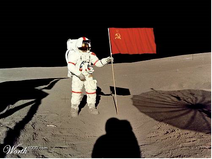
1973
The Soviets successes in the early 70s were just beginning
April 3rd: The Salyut 2 space station is launched as a follow up to the previous manned station Salyut 1. Its launch upstaged the launch of the highly anticipated American Skylab station that followed weeks later. Rumors quickly spread that the Station was a 'Military Salyut'. The secrecy surrounding the Almaz station was due to the fact it was primary purpose was to develop and test manned Reconnaissance from orbit.
May 14th: The Americans launch the highly anticipated Skylab Station on a modified Saturn V. The station was critically damaged during launch with micrometeor impacts, one of it's two main solar panels destroyed, temperatures inside began building up releasing toxic chemicals inside. The launch was a complete failure. and a big blow to American morale.Many blame congress for cutting the Apollo Applications program in 1968 which would have allowed Americans to have a Skylab in 1968.
June: In the wake of the Skylab failure, the soviet yet again prove their space superiority with the launch and docking of Soyuz 13 as it arrived at Salyut 2. The crew began longer and longer stays. Soyuz 14 also visited the station for resupply and vehicle swap out. A six-person crewed station.
n addition to the Space Station Success the Soviets also manage to launch two Moon flights this time scaling the landing crew up to two and the duration on the surface up to 24 hours. The missions where also the debut of the Russians manned lunar rover. The Soviets also announced plans for a permanent Lunar Base.
The Americans manage to upstage this with their launch of the LM shelter, a vehicle that extends the surface stay of Apollo crews up to 30 days on the surface as well as allowing the CSM time to explore the entire surface on the Moon from Earth Orbit
1974
August: The Americans finally launch the replacement for the failed Skylab, Skylab B. The launch is perfect success. This is followed by the launch of the manned Skylab 2 which begins the first in permanent residence in Space with the crew spending an incredible entire year in space in preparation for the planned Space Base, Moon Base and Mars flights. It is resupplied by three more manned Apollo CSMs who visit the station in sequence.
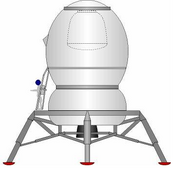
December: This important achievement was overshadowed by the end of the year with shock as the Soviets launch the new L3M lunar lander. The heavier vehicle was a direct landing without the need for Rendezvous in Lunar Orbit (although it did require two N-1 launches instead of one). Not only had the crew size been expanded to three cosmonauts, but the duration spent on the moon was increased from just one day to ninety. The Soviet proudly proclaimed, the first outpost on the moon has been set up.
1975
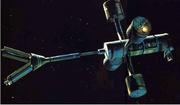
In the wake of the Americans successful Skylab program, the US launched the 'Space Base' on a modified Saturn V similar to the one used to launch Skylab. Followed by the Space Shuttle a fully re-usable two-stage to orbit vehicle with a crew of 12. This first modular space station could be built up by multiple flights.
Meanwhile the Soviets because of budgetary concerns dropped all future Lunar flights. The stagnating and soon to be declining Brezhnev-era economy couldn't keep funding the Space Program at this rate.
The Soviets did manage to successfully fly their new TKS spacecraft (an Almaz station, a VA capsule and a docking port launched together on a Proton) which further added to American suspicions of a Soviet mega-station. The six-person vehicle attempted to catch up to the American's new duration record with a 90 day flight but were obviously lagging seriously behind in all areas but Venus probes.
1976
The American Bicentennial was an active time for US as the 'Race for Mars' continued. The Americans had at last caught up with the Soviets and Launched their LESA (also known as Apollos 20, 21 and 22) building up to gradually to eventual six person Manned 180 day extended lunar missions. The established Goddard Lunar Base would continue to operate for decades until eventually replaced.
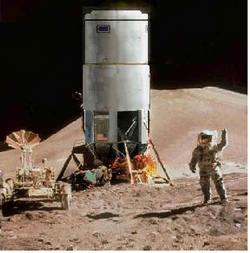
The Americans launched the Viking 1 and 2 landers which utterly surpassed the Mars 2, 3 and 7 Lander/Mini Rovers. The positive results of two out of their three biological experiments combined with the Viking Orbiters discovery of dry rivers, lakes and oceans intensified the public excitement as the Ares Program developed.
1975-1977
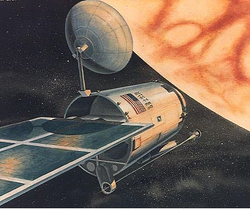
Humanity's first Interplanetary Mission was launched by the United States on February 28th. Known as Apollo X the spacecraft performed piloted flybys of not just Mars but also Venus twice and several Main Belt Asteroids. The crew of six dropped off Orbiters, Balloons, Impactors and Landers at Venus while taking high resolution close-up observations of the planet All this Before proceeding on to Mars and releasing and relaunching three Sample Return Landers. The crew also became the first humans to enter the Asteroid Belt having made it as far out as 2.3 AU. The Total Duration of the Flight was 760 days. The Vehicle itself was the spent Saturn IVB upper stage that sent them on their way converted to a Wet Workshop, A CSM was docked to one side for eventual re-entry.
It and along with two Jupiter-Saturn-Pluto and two Jupiter-Uranus-Neptune flyby probes comprise what came to be known as the "Planetary Grand Tour" for the 1977 launch year. The crew splashed down Apollo style in Nov 1977
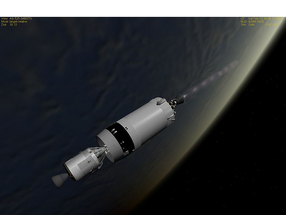
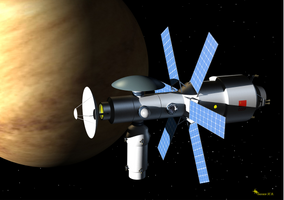
1978
In preparation for the upcoming Mars Landing NASA conducted two test flights of the Mars Excursion Module, the planned lander that would take human beings to Mars. The first was a 200-day unmanned flight, the other a two-day flight piloted by a crew. Both culminated in a Re-Entry into the Earth's atmosphere to simulate landing controlled on Mars (as well as testing the heat shield and parachute, guidance, communications, and docking capability of the spacecraft).
1980
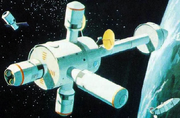
The Space Base reached its maximum permanent capacity of 100 people with its completion. Several Modules had been added since its launch in 1975 by the Space Shuttle and now boast a hundred people living and working in space. Many working on Astronomy, Life Science, Earth Science, Biology, Physics and Military Reconnaissance.
1981-1984
The World's first manned mission to mars begins construction. The Saturn V-25(S)U was a modified vehicle designed to carry over 250 tonnes to Earth Orbit. Two launches were required to send up the NERVA rocket stages that would launch the crew to Mars and one launch was required to launch the crew, partially filled upper stage, Lander and Interplanetary Module they would be living in for two years. Two vehicles were built for redundancy purposes
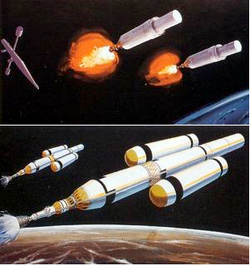
The crew departed from their parking orbit near the space station on November 12th 1981. After a coast of six months the crew of 12 arrived in a highly elliptical Mars Orbit on the 9th of May 1982.
The crew descended in their Mars Excursion Modules before staying an incredible year and a half on the surface. During this time they explored the surface in rovers and searched for signs ]of microbial life and past water (finding the latter but not the former yet).
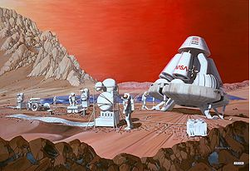
On November 5th 1983 the crew returned to the orbiting mother ships and launched six month transfer back to earth. As they did so another mission (using the spare) was launched from earth. On the way back they Flyby Venus and release two Lander Probes.
May 12th 1984 the first manned mission to Mars finally arrived back at low earth orbit although it would be some time before they were allowed to return to earth after being quarantined on Space Base to protect from possible Martian pathogens.
